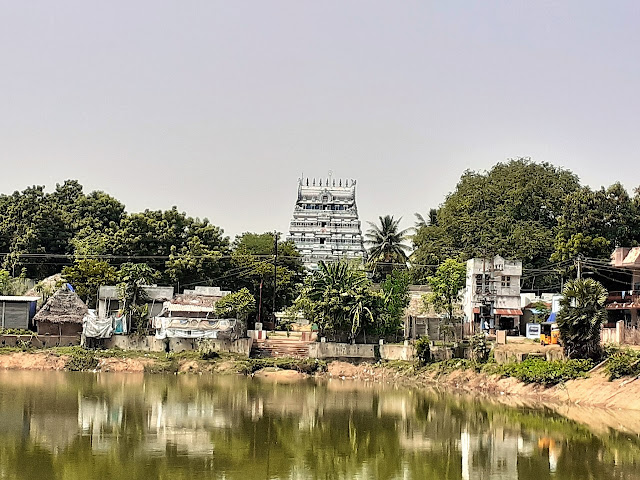Innambur Ezhutharinathar Temple – The Divine Scribe of Kumbakonam
Location
- Village:
Innambur
- Taluk:
Kumbakonam
- District:
Thanjavur, Tamil Nadu
- Access:
Located on the northern bank of the River Kaveri, easily reachable from
Kumbakonam (~8 km)
Deities and Subshrines
- Main
Deity: Lord Shiva as Ezhutharinathar
(also called Ezhuthari Natheswarar), symbolizing the divine scribe and
cosmic accountant
- Consort:
Goddess Parvati as Nithya Kalyani or Sugantha
Kundalambigai, representing eternal auspiciousness
- Subshrines
include:
- Vinayaka
(Ganesha)
- Murugan
(Subrahmanya)
- Dakshinamurthy
- Navagrahas
- Chandikeswara
- Lingas
installed by sages and celestial beings
Temple Significance
- Paadal
Petra Sthalam: One of the 276 sacred Shiva temples
praised in the Thevaram hymns by Tamil Saiva saints (Nayanmars),
especially Appar and Sundarar
- Spiritual
Theme: The temple is associated with divine
intervention in record-keeping. A legend tells of Lord Shiva appearing as
a scribe to complete temple accounts overnight, earning the name Ezhutharinathar—“He
who writes”
- Symbolism:
The temple emphasizes the sanctity of truth, accountability, and divine
support in righteous duties
- Architectural
Style: Dravidian architecture with a
prominent gopuram, pillared halls, and a serene temple tank
History
- The
temple dates back to the Chola period, with inscriptions and
structural elements indicating patronage from Chola kings and later Nayak
rulers.
- It
is one of the 276 Paadal Petra Sthalams, sanctified by the hymns of
Appar and Sundarar, Tamil Saiva saints of the 7th century.
- The
temple’s historical name is Innambur, and it has long been a center
of Shaiva worship and temple administration.
Legends
- A
famous legend tells of a royal accountant who struggled to complete
temple ledgers. Fearing punishment, he prayed to Lord Shiva.
- That
night, Shiva appeared as a scribe and completed the records
flawlessly. The king was astonished, and the deity was henceforth called Ezhutharinathar—“He
who writes.”
- This
story symbolizes divine intervention in righteous duties and the sanctity
of truth and accountability.
- The
temple is also associated with Iravadha Theertham, a sacred tank
believed to have been created by Indra’s elephant.
Architecture
- The
temple follows Dravidian architectural style, with a prominent gopuram,
pillared mandapams, and a serene temple tank.
- The
main sanctum (garbhagriha) houses Lord Shiva as Ezhutharinathar in
lingam form, facing east.
- The
goddess Nithya Kalyani (Sugantha Kundalambigai) has a separate
shrine, reflecting divine feminine grace.
- The
temple features a Shenbagam tree as its sacred sthala virutcham and
includes shrines for Vinayaka, Murugan, Navagrahas, Dakshinamurthy,
and Chandikeswara.
- The
layout and stone carvings reflect the elegance and symmetry typical of
Chola-era temples.
Daily Rituals
- Three
daily pujas are performed following Shaiva Agama
traditions, including:
- Kalasanthi
(morning)
- Uchikalam
(midday)
- Sayaraksha
(evening)
- Rituals
include abhishekam (sacred bath), alankaram (decoration), naivedyam
(food offerings), and deepa aradhana (lamp worship) to both Lord
Ezhutharinathar and Goddess Nithya Kalyani
- Mondays
and Pradosham days are considered especially auspicious for Shiva
worship
Major Festivals Celebrated
1.
Navratri (Purattasi – Sep–Oct):
o Celebrated
for 10 days with special pujas, Vedic homams, and daily
abhishekams using milk, honey, and sandal paste
o Devotees
seek blessings from Goddess Nithya Kalyani for marital harmony and spiritual
upliftment
2.
Maha Shivaratri (Maasi – Feb–Mar):
o Night-long
vigil with four kala pujas, chanting of Shiva mantras, and lamp
offerings
o Devotees
fast and offer prayers for liberation and divine grace
3.
Thiruvadhirai (Margazhi – Dec–Jan):
o Celebrates
Lord Shiva’s cosmic dance (Ananda Tandavam)
o Includes
special abhishekam and Arudra Darshan
4.
Panguni Uthiram (Mar–Apr):
o Marks
the celestial wedding of Shiva and Parvati
o Kalyana
Utsavam is performed with community participation
5.
Aadi Pooram (Jul–Aug):
o Celebrates
the divine feminine energy of Goddess Nithya Kalyani
o Includes
special Devi pujas and processions
Beliefs and Spiritual Significance
- Lord
Ezhutharinathar is worshipped as the divine
scribe, who once completed temple accounts overnight to save a
devotee, symbolizing divine support in righteous duties
- The
temple is believed to bless devotees with clarity, learning, and
accountability, making it popular among students, scholars, and
professionals
- Goddess
Nithya Kalyani is believed to grant marital
harmony, fertility, and auspiciousness
- The
temple’s sacred tank, Iravadha Theertham, is believed to have been
created by Indra’s elephant and is considered spiritually purifying
Temple Hours
- Morning:
6:00 AM – 11:00 PM
- Evening:
4:00 PM – 8:00 PM
- Aarti
& Abhishekam: Performed during morning and
evening pujas
- Dress
Code: Modest traditional attire recommended
Getting Here
- By
Road:
- From
Kumbakonam: ~8 km (15–20 minutes)
- From
Thanjavur: ~40 km
- From
Chennai: ~280 km via NH38
- By
Rail:
- Nearest
station: Kumbakonam Railway Station
- Regular
trains from Chennai, Trichy, Madurai
- By
Air:
- Nearest
airport: Tiruchirapalli International Airport (~90 km)
- From
there, take a taxi or bus to Kumbakonam
Tips
- Best
Time to Visit: November to February for pleasant
weather and festival season
- Combine
Visits: Ideal to pair with nearby Paadal
Petra Sthalams like Thiruppurambiyam, Swamimalai, and Thirunageswaram
- Local
Transport: Auto-rickshaws and taxis available
from Kumbakonam
- Stay
Options: Budget and mid-range hotels in
Kumbakonam; book early during festivals
- Photography:
Allowed in outer precincts; avoid flash near sanctum
- Spiritual
Tip: Reciting Thevaram hymns during darshan enhances
the experience, as this is a revered site in Tamil Saiva tradition











Post a Comment